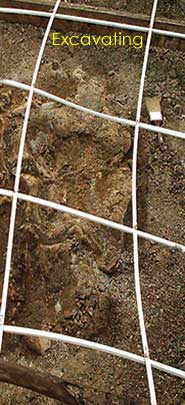
|
 |
||||
Once the fossil is located preparations must be made to excavate (dig out) the remains. Supplies and tools include; eager staff, brushes, trowels, shovels, burlap, plaster and consolidant. A large area surrounding the original piece would be excavated to ensure all pieces would be located. The shale (rock) is very brittle and light dusting with brushes is adequate to remove the thin layers.
After the specimen is fully exposed proper analysis must be made of the sight before removal. Field notes are taken including date, time and weather conditions. A brief summary of the site is recorded and photographs are taken along with a site map. A grid is set up and a drawing of the specimen in situ is recorded and numbered for future reference and excavation.
Field notes of the site should include exact location with a GPS (global positioning system) the distribution of the material, association, preservation, sediments/geology and a possible identification of the specimen. The number and type of bones are also recorded for possible identification. All information from the site is filed for future study.
Once the field notes are complete the specimen is ready for removal. Field jackets are applied and transported back to the museum for further preparation.